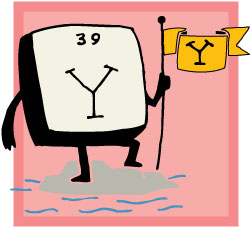Blogging the Periodic Table

When it comes to the discovery of elements on the periodic table, you can divide the world into two parts—Ytterby, and everywhere else. Ytterby ("itt-ter-bee") is a village on a speck of an island outside of Stockholm. But no place on earth has been more important to the periodic table. A few places—if you count Latin names—can brag that two elements have been named for them. Ytterby has four. And it could have had more, since three other elements can trace their discovery to a modest mine that once supported the community there.
There are a few reasons why so much scientific energy was concentrated in such a small space as Ytterby. First is the type of elements discovered there. All seven of Ytterby's elements were rare-earth elements, and (for reasons explained in a previous post) rare earths mix together in the ground almost indistinguishably. Where you discover one, you're going to find many others, and Sweden just happens to have rich deposits of rare earths. What's more, glaciers during the last Ice Age shaved away the top layers of soil over much of Sweden, exposing those deposits for easy mining.
Another important reason is economic. The Ytterby mine opened not to find new elements (no money in that) but to find a mineral called feldspar. Feldspar is crucial for making Chinese porcelain, which Europeans had coveted since the days of Marco Polo in the 1300s. Two European chemists finally figured out how to make porcelain on their own circa 1700. (One of the duo, a teenager, had been condemned to death as a swindler and failed royal alchemist; he promised to discover the secrets of porcelain in exchange for his life, and succeeded.) Swedes liked porcelain because it made better stoves to warm their homes than iron did, and the mine ( Ytterby gruva in Swedish) opened in the late 1700s to cash in on the demand.
That still doesn't quite explain, though, why people discovered new elements there. Locals could have just mined the feldspar and dumped everything else in a refuse heap. But something else was happening, socially, in Sweden around that time—a scientific enlightenment. Geologists and chemists heard stories about the unusual minerals turning up in Ytterby and began shipping them to the world expert on such rocks, a Swede named Johan Gadolin.
Gadolin—an acquaintance of the legendary English porcelain maker Josiah Wedgwood—didn't quite have the technology to separate out all the elements in the rocks he examined. (Again, even 200 years later, rare earths are a real pain to get apart.) But Gadolin did discover at least one pure element and proved that others were concealed in the rocks. In fact, when later chemists with better tools set to work on the Ytterby lode, six more elements fell out.
Four of the names of these elements come straight from Ytterby—ytterbium, yttrium, terbium, and erbium. The names couldn't get much shorter—rbium doesn't look right—so for the rest, chemists picked holmium, after Stockholm; thulium, after a mythic name for Scandinavia; and gadolinium, after Gadolin himself.
Today, a visitor to Ytterby might never realize this island was the Galápagos of the periodic table, a place whose dazzling variety gave chemists crucial insights into their field. The mine shut down long ago, and trees and weeds have since grown over it. But at least the island itself hasn't forgotten its legacy. A small plaque on a rock near the mine commemorates the discoveries made there. And some local streets are named for elements—making it perhaps the only place in the world where knowledge of the periodic table is useful for getting around town.
Like Slate on Facebook. Follow us on Twitter.